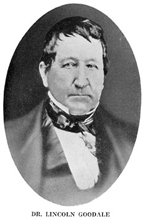
Columbus, Ohio USA
Return to Homepage www.shortnorth.com
The Short North That Was
Dr. Lincoln Goodale and His Living Legacy
Part One
December 2006 Issue
by Beverly Mullet Randall
email bmullet@netwalk.com
Dr. Lincoln Goodale, Courtesy of the Columbus Metropolitan Library, Division of Biography,
History & TravelGoodale Street and Goodale Park lie in the heart of the Short North. Both were named after Dr. Lincoln Goodale, a man whose story deals in superlatives but is scarcely remembered today. He was one of first and oldest residents of Columbus and Ohio and the county’s first doctor. As Columbus’ first millionaire, he was one of the city’s greatest and most benevolent benefactors. Through marriages and business dealings, the Goodale family interwove the fabric of central Ohio’s business community and society.
At the south entrance of the park that bears his name, the bust of Dr. Lincoln Goodale still faces the city he loved and presides over the land he provided to ensure that its people, especially the poor, would have an oasis of nature and beauty to enjoy for years to come in Goodale Park. Through his generosity and especially his donation of Goodale Park, Dr. Goodale continues to touch the lives of the people of Columbus over 200 years after his arrival in Franklinton in 1805.Goodale Family History
Dr. Lincoln Goodale was born in 1782, in Worchester, Massachusetts, the son of Nathan Goodale, another well-loved citizen and community leader. Having distinguished himself in the Revolutionary War as a brave and ingenious leader, Capt. Nathan Goodale decided to move his family to Marietta, Ohio, after the war with a number of other Massachusetts families. While preoccupation with the Revolutionary War had caused farming innovations to stall or even deteriorate, Nathan worked to improve cattle stock. Instead of using oxen or horses to pull his family’s wagons to Ohio, he selected three of the best cows and one of the finest bulls in the area and trained them to work as a team. They not only performed as well as oxen for pulling wagons, but provided milk for the family on the journey to Ohio. These four animals and their offspring spread throughout the Ohio community and were known as the “Goodale breed,” with many retaining the original characteristics of the first four’s gentle dispositions, perfect conformation, and superior milk-producing qualities.
The settlers arrived in Marietta, Ohio, in 1788, coming from West Virginia on a flatboat. Lincoln Goodale and his siblings were part of the first party of women and children to arrive in Marietta, Ohio – Ohio’s first city. A few years later, the Goodale family moved fourteen miles south to Belpre on the Ohio River. Nathan Goodale quickly became a community leader through his innovative farming techniques and military experience. The early 1790s were a dangerous time in the frontier as the Americans, British, French and Indians skirmished with various conflicts.
By unanimous consent of the community, Nathan was appointed to be in charge of managing community defense. In that role, he planned and directed the construction of a fortified stockade village in 1791 called Farmers’ Castle Fort where most of the community lived for about two years. In 1793, they erected two more stockades. On March 1, 1793, Nathan Goodale was working his farm when he disappeared – his oxen were found standing in their yoke but he was gone and the moccasin footprints in the snow revealed he had been captured by Indians.
A tracking party tried to follow the footprints but eventually lost them. The family and community were overwhelmed and saddened by his loss and were deeply concerned that he might be tortured. Years passed and he never returned. He was considered to be the “life and soul” of the community and was remembered fondly years after his disappearance. After his capture, the community felt much more vulnerable and petitioned General Washington for additional protection, fearing the settlement would break up completely without it.
During the Treaty of Greenville in 1795, an effort was made to find out what had happened to Nathan Goodale, but no one seemed to know and it remained a mystery until 1799 when it was discovered through a chance conversation between Col. Forrest Meeker, who knew Maj. Goodale, and three Indians he fell in with in the Detroit area that he had been captured and was en route to Detroit to be held for ransom when he died of pleurisy. This story was later corroborated by the wife of an Indian trader near Sandusky, Ohio, who said he had died at her home, far from his family and friends but that he had not been subjected to any mistreatment other than what was necessary to keep him from escaping.
While still living in Belpre after his father’s disappearance, Lincoln Goodale took up the study of medicine, reading under the preceptorship of Dr. Leonard Jewett. At the time, anyone who “thought himself fit” could study and practice medicine, but early settlers were appreciative of those who did practice regardless of a lack of extensive formal training and facilities. In 1805, Dr. Lincoln Goodale and his widowed mother came to Franklinton, Ohio (west Columbus). He was 23 and the first physician to settle in the county.
Special thanks to the Columbus Metropolitan Library, Division of Biography, History and Travel for their help.©2006 Short North Gazette, Columbus, Ohio. All rights reserved.
